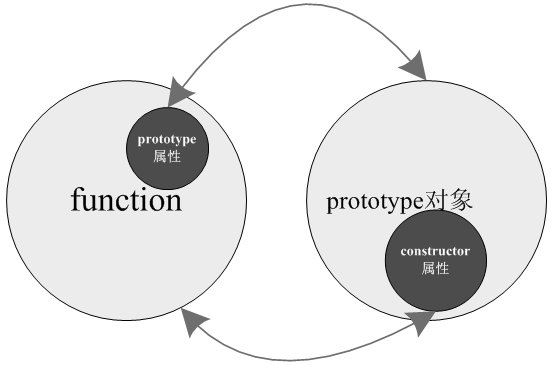关于js中Prototype属性的解释和方法,看了某位大佬总结的一片博客,写的非常好啊,收益了,我这里转载备份一下,也加点一些小理解。后面有Prototype属性的新理解的话,会继续补充。不过关于原文中的类方法好像有点争议,有大佬科普下吗?
原文:http://www.cnblogs.com/wdlhao/p/5743770.html
1、prototype的定义
javascript中的每个对象都有prototype属性,Javascript中对象的prototype属性的解释是:返回对象类型原型的引用。
每一个构造函数都有一个属性叫做原型。这个属性非常有用:为一个特定类声明通用的变量或者函数。
你不需要显式地声明一个prototype属性,因为在每一个构造函数中都有它的存在。你可以看看下面的例子:
function Test(){}
alert(Test.prototype); // 输出 "Object"
1.1、 原型法设计模式
原型法的主要思想是,现在有1个类A,我想要创建一个类B,这个类是以A为原型的,并且能进行扩展。我们称B的原型为A。
1.2、javascript的方法可以分为三类:
a 类方法
b 对象方法
c 原型方法
function People(name)
{
this.name=name;
//对象方法
this.Introduce=function(){
alert("My name is "+this.name);
}
}
//类方法
People.Run=function(){
alert("I can run");
}
//原型方法
People.prototype.IntroduceChinese=function(){
alert("我的名字是"+this.name);
}
//测试
var p1=new People("Windking");
p1.Introduce();
People.Run();
p1.IntroduceChinese();
1.3、给prototype添加属性
就如你在上面所看到的,prototype是一个对象,因此,你能够给它添加属性。你添加给prototype的属性将会成为使用这个构造函数创建的对象的通用属性。
例如,我下面有一个数据类型Fish,我想让所有的鱼都有这些属性:livesIn="water"和price=20;为了实现这个,我可以给构造函数Fish的prototype添加那些属性。
function Fish(name, color){
this.name=name;
this.color=color;
}
Fish.prototype.livesIn="water";
Fish.prototype.price=20;
var fish1=new Fish("mackarel", "gray");
var fish2=new Fish("goldfish", "orange");
var fish3=new Fish("salmon", "white");
for (int i=1; i<=3; i++){
alert(fish.name+","+fish.color+","+fish.livesIn+","+fish.price);
}
输出应该是:
"mackarel, gray, water, 20" "goldfish, orange, water, 20" "salmon, white water, 20"
你看到所有的鱼都有属性livesIn和price,我们甚至都没有为每一条不同的鱼特别声明这些属性。这时因为当一个对象被创建时,这个构造函数 将会把它的属性prototype赋给新对象的内部属性__proto__。这个__proto__被这个对象用来查找它的属性。
你也可以通过prototype来给所有对象添加共用的函数。这有一个好处:你不需要每次在构造一个对象的时候创建并初始化这个函数。为了解释这一点,让我们重新来看Example DT9并使用prototype来重写它。
1.4、用prototype给对象添加函数
function Employee(name, salary){
this.name=name;
this.salary=salary;
}
Employee.prototype.getSalary=function getSalaryFunction(){
return this.salary;
}
Employee.prototype.addSalary=function addSalaryFunction(addition){
this.salary=this.salary+addition;
}
var boss1=new Employee("Joan", 200000);
var boss2=new Employee("Kim", 100000);
var boss3=new Employee("Sam", 150000);
输出的结果为:
alert(boss1.getSalary()); // 输出 200000 alert(boss2.getSalary()); // 输出 100000 alert(boss3.getSalary()); // 输出 150000
子类如何重写父类的属性或方法:
function AClass(){
this.Property = 1;
this.Method = function(){
alert(1);
}
}
function AClass2(){
this.Property2 = 2;
this.Method2 = function(){
alert(2);
}
}
AClass2.prototype = new AClass();
AClass2.prototype.Property = 3;
AClass2.prototype.Method = function(){
alert(4);
}
var obj = new AClass2();
alert(obj.Property);
obj.Method();
输出结果为:
//3 //4
可以在对象上增加属性或方法
function Aclass(){
this.Property = 1;
this.Method = function(){
alert(1);
}
}
var obj = new Aclass();
obj.Property2 = 2;
obj.Method2 = function(){
alert(2);
}
alert(obj.Property2);
obj.Method2();
输出结果为:
//2 //2
function Aclass(){
this.Property = 1;
this.Method = function(){
alert(1);
}
}
Aclass.prototype.Property = 2;
Aclass.prototype.Method = function{
alert(2);
}
var obj = new Aclass();
alert(obj.Property);
obj.Method();
输出结果为:
//1 //1
1.5、A.prototype = new B();
理解prototype不应把它和继承混淆。A的prototype为B的一个实例,可以理解A将B中的方法和属性全部克隆了一遍。A能使用B的方法和属性。这里强调的是克隆而不是继承。可以出现这种情况:A的prototype是B的实例,同时B的prototype也是A的实例。
先看一个实验的例子:
function baseClass(){
this.showMsg = function(){
alert("baseClass::showMsg");
}
}
function extendClass(){}
extendClass.prototype = new baseClass();
var instance = new extendClass();
instance.showMsg(); // 显示baseClass::showMsg
我们首先定义了baseClass类,然后我们要定义extentClass,但是我们打算以baseClass的一个实例为原型,来克隆的extendClass也同时包含showMsg这个对象方法。
extendClass.prototype = new baseClass()就可以阅读为:extendClass是以baseClass的一个实例为原型克隆创建的。
那么就会有一个问题,如果extendClass中本身包含有一个与baseClass的方法同名的方法会怎么样?
下面是扩展实验2:
function baseClass(){
this.showMsg = function(){
alert("baseClass::showMsg");
}
}
function extendClass(){
this.showMsg =function (){
alert("extendClass::showMsg");
}
}
extendClass.prototype = new baseClass();
var instance = new extendClass();
instance.showMsg();//显示extendClass::showMsg
实验证明:函数运行时会先去本体的函数中去找,如果找到则运行,找不到则去prototype中寻找函数。或者可以理解为prototype不会克隆同名函数。
那么又会有一个新的问题:如果我想使用extendClass的一个实例instance调用baseClass的对象方法showMsg怎么办?
答案是可以使用call:
extendClass.prototype = new baseClass(); var instance = new extendClass(); var baseinstance = new baseClass(); baseinstance.showMsg.call(instance);//显示baseClass::showMsg
这里的baseinstance.showMsg.call(instance);阅读为“将instance当做baseinstance来调用,调用它的对象方法showMsg”
好了,这里可能有人会问,为什么不用baseClass.showMsg.call(instance);
这就是对象方法和类方法的区别,我们想调用的是baseClass的对象方法
1.6、对象方法与通过new创建对象的重要区别
这个区别就是function定义的方法(对象方法)有一个prototype属性,使用new生成的对象就没有这个prototype属性。也就是prototype属性是对象方法或者构造方法的专有属性。 prototype属性又指向了一个prototype对象,注意prototype属性与prototype对象是两个不同的东西,要注意区别。在prototype对象中又有一个constructor属性,这个constructor属性同样指向一个constructor对象,而这个constructor对象恰恰就是这个function函数本身。如下所示:
 (这个图没看懂啊=-=,又涉及到了constructor)
(这个图没看懂啊=-=,又涉及到了constructor)
function Person(name)
{
this.name=name;
this.showMe=function()
{
alert(this.name);
}
};
var one=new Person('js');
alert(one.prototype)//undefined
alert(typeof Person.prototype);//object
alert(Person.prototype.constructor);//function Person(name) {...};
最后,下面这个代码如果理解清晰,那么这篇文章说的就已经理解了:
1 <script type="text/javascript">
2
3 function baseClass()
4 {
5 this.showMsg = function()
6 {
7 alert("baseClass::showMsg");
8 }
9
10 this.baseShowMsg = function()
11 {
12 alert("baseClass::baseShowMsg");
13 }
14 }
15 baseClass.showMsg = function()
16 {
17 alert("baseClass::showMsg static");
18 }
19
20 function extendClass()
21 {
22 this.showMsg =function ()
23 {
24 alert("extendClass::showMsg");
25 }
26 }
27 extendClass.showMsg = function()
28 {
29 alert("extendClass::showMsg static")
30 }
31
32 extendClass.prototype = new baseClass();
33 var instance = new extendClass();
34
35 instance.showMsg(); //显示extendClass::showMsg
36 instance.baseShowMsg(); //显示baseClass::baseShowMsg
37 instance.showMsg(); //显示extendClass::showMsg
38
39 baseClass.showMsg.call(instance);//显示baseClass::showMsg static
40
41 var baseinstance = new baseClass();
42 baseinstance.showMsg.call(instance);//显示baseClass::showMsg
43
44 </script>
注意第十五行的是类方法,作者这里打上static的调试信息,那有点和Java的静态有点像了啊,类共用,一个模版,js上面代码这里专门用来区别第五行的对象方法,两个输出的信息不一样。第三十九行和四十二行显示了结果。在上面的extendClass的一个实例instance调用baseClass的对象方法showMsg 也有提到。
